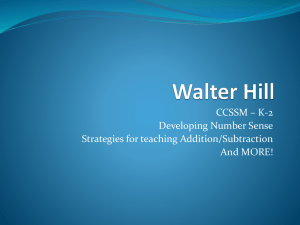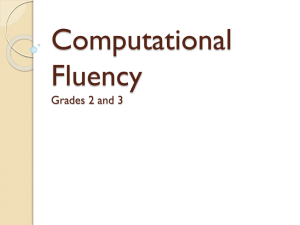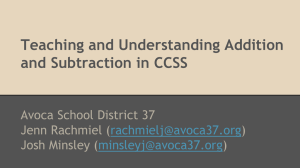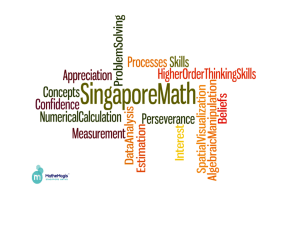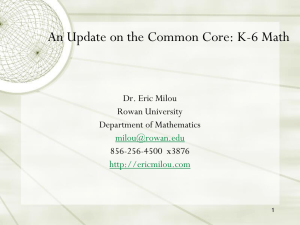Day 2 Addition/Subtraction ppt.
advertisement
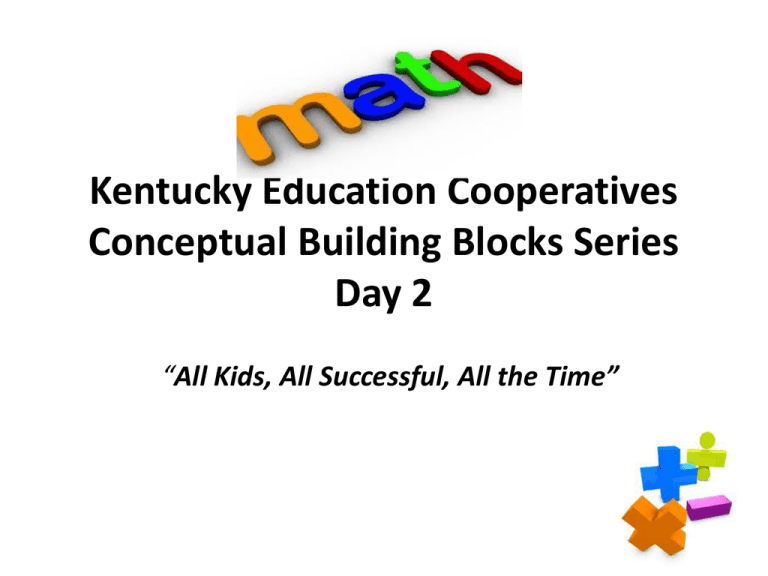
Kentucky Education Cooperatives Conceptual Building Blocks Series Day 2 “All Kids, All Successful, All the Time” Addition and Subtraction Day 2 • Addition and Subtraction Strategy Progressions • Story Problems • Place Value • Addition and Subtraction Strategies • Identifying Error Patterns • Center Activities Alphabet Addition and Subtraction • Add D and E • Subtract C from F • Add P and J Addition and Subtraction Strategies • Count all (two collections) • Count on • Count back/count down to/count up from Developing Essential Understanding of Addition and Subtraction Pre-K – Grade 2, NCTM publication, page 78, Early Numeracy Research Project (Clarke, 2001) Addition and Subtraction Strategies • Basic strategies • Derived strategies • Extending and applying addition and subtraction using basic, derived and intuitive strategies Developing Essential Understanding of Addition and Subtraction Pre-K – Grade 2, NCTM publication, page 78, Early Numeracy Research Project (Clarke, 2001) Combinations and Partitions Activities • Build fluency to 5 • Build fluency to 10 • Build Part-Part-Whole Understanding • Combinations and Partitions of 20 Using: Five frames, ten frames, linking cubes, domino patterns, 20 frames K.OA, K.NBT, 1.OA, 2.OA.3 Begin with Five! Move to ten! Think of a way to make 7 Begin building on and off from a number Part-Part-Whole and Whole-part-part • Use of five, ten, and twenty frames with no empty boxes. Show all partitions of the whole. • Use of five, ten, and twenty frames with some empty boxes. Show all combinations of the whole. Use of Frames Use of Frames Doubles on a Bead Rack • Objectives – Help students visualize doubles (e.g., 4+4; 6+6) – Help students use doubles in computation • The visualization is key: 1+1=2 2+2=4 3+3=6 4+4=8 Check Up • Bunny Ears One hand – to combine and partition within five Two hands – to combine and partition within ten Five and Ten Frames Empty Use counters Check Up • Ask the students to give the combinations and partitions of numerals to five What goes with three to make five? If I have two, how many more do I need to make five? What two numbers combine to make five? If I have two pencils, how many more do I need to have four pencils? For our struggling students • Some students have difficulty in thinking about partitioning quantity. Use cubes that will fit on their finger tips Use Velcro and structure Use foam ten frames with removable dots Use Wiki Sticks to assist in building the symbols Salute! From Kentucky Center for Mathematics, Kentucky Numeracy Project Intervention Guide www.kymath.org Understanding Addition and Subtraction Situations The standards stress the importance of students being able to use addition and subtraction in all situations. The Four main problem types are: Add to Take from Put Together and Take Apart Compare (With unknown in all positions) Addition and Subtraction Situations Problem Type Add To Result Unknown Change Unknown Start Unknown Take From Result Unknown Change Unknown Start Unknown Put together and take apart Total Unknown Both Addends unknown Addend Unknown Compare Difference Unknown Bigger Unknown Smaller Unknown We normally see problems that ask students to “join” or “separate” to find the unknown part. We tend to ask students to “put together” for addition and “take from” for subtraction. These definitions are limited and if these are the only exposure students have, they will have difficulty when the situation calls for something other than “put together” or “take away”. Take for example, the following problem: Bob has 3 nickels and Bill has 7 nickels. How many more nickels does Bill have than Bob? Problem Solving Mat Story Problems • Use of quantity in context assists students in attaching meaning to quantity, as well as, the actions of the operations • Incorporate number talks along with the story problems • Develop problem strings along with the story to assist students to develop efficient strategies K.OA.2, 1.OA.1, 2, 2.OA.1 Story Mats Frog Story Mat Gathering for Winter Whole Group Activity Place Value • Conceptual place value develops as students are involved in mental math strategies. • Positional place value should not be taught in a procedural memorized manner. It gets in the way of a students development of a conceptual understanding. Developing Number Knowledge, 2012. Wright, Robert J., Ellemor-Collins, David., and Tabor, Pam. Sage Publications. Unitizing and Place Value • Unitizing in place value is the understanding that ten ones is the same one ten. • Represents a HUGE shift in understanding • 56 is 5 tens and 6 ones and is also: 4 tens and 16 ones 3 tens and 26 ones 2 tens and 36 ones 1 ten and 46 ones 56 ones Developing Number Knowledge, 2012. Wright, Robert J., Ellemor-Collins, David., and Tabor, Pam. Sage Publications. Place Value • Grouping items Cups and counters Sticks and bundles Dot strips Ten frames K.NBT, 1.NBT.2,3, 4, 5,6, 2.NBT.1, 2, 3, 4 A Conceptual Understanding of Ten = Developing Number Knowledge, 2012. Wright, Robert J., Ellemor-Collins, David., and Tabor, Pam. Sage Publications. Adding and Subtracting Tens to a Decade = 3 tens or 30 Developing Number Knowledge, 2012. Wright, Robert J., Ellemor-Collins, David., and Tabor, Pam. Sage Publications. Adding and Subtracting Tens off the Decade and 23 and “23… 33, 43, “43” 20 Developing Number Knowledge, 2012. Wright, Robert J., Ellemor-Collins, David., and Tabor, Pam. Sage Publications. Adding and Subtracting Tens and Ones + 23 and 22 20, “30, 40, 43, 44, 45” Developing Number Knowledge, 2012. Wright, Robert J., Ellemor-Collins, David., and Tabor, Pam. Sage Publications. Using Bundles and Sticks 300 (3 groups of hundreds), 20 (2 groups of tens), and 4 (4 sticks) 324 Developing Number Knowledge, 2012. Wright, Robert J., Ellemor-Collins, David., and Tabor, Pam. Sage Publications. 7 + 5 What moves do you want to make? Using Dots 300 (3 hundreds), 20 (2 tens) and 4 (4 ones) is 324 “Gretchen” Video Mental Math • Solve the following: 43 + 28 65 - 27 1.NBT.4, .5, .6; 2. NBT.7 .8. 9; 3.NBT.2; 4. NBT.4 Student Work Betty 43 + 28 61 Chad 43 + 28 711 Alice “40 + 20 is 60 and 8 + 3 is 11 and 60 + 10 is 70, and one more is 71” Student Work Lisa’s Work 65 - 27 42 Jason’s Work 65 – 27 = “37, 47, 57, is 30, then 3 more is 60, 5 more is 33+5 is 38” Common Misconceptions when adding and subtracting • “Subtract the smaller from the larger” is a rule that children apply regardless of minuend or subtrahend. 62 – 45 = 23 • Not regrouping 34 + 28 = 52 • Ignoring the zeros 2 13 303 – 154 259 Instructional materials that support children in using mental math strategies • Use of composite units Bundles and Sticks Dot Strips Frames Dots on popsicle sticks Unifix Cubes – Towers Cups and counters 100 Bead Rack Base Ten Blocks Thou Shall Not CARRY 38 + 49 Strategies based on Place Value 38 + 49 38 is 30 + 8 49 is 40 + 9 30 and 40 make 70 8 + 9 make 17 which is 10 and 7, so 70 and 10 is 80 plus 7 is 87 Your Turn • Use the split strategy to solve the following: 56 + 32 134 + 643 A Jump Strategy 38 + 49 49 + 10 is 59, plus 10 is 69, plus 10 is 79, then one more is 80, then 7 more is 87 +10 +10 +10 +1 +7 ______________________________________ 49 59 69 79 80 87 Your Turn • Solve the following using a jump strategy 64 + 33 132 + 54 Partial Sums 38 + 49 70 17 87 136 + 553 600 80 9 689 267 + 841 1000 100 8 1108 Partial Sums Expanded Notation 533 + 327 500 + 30 + 3 300 + 20 + 7 800 + 50 + 10 = 860 Your Turn • Solve the following using a partial sums strategy 327 + 488 Why do so many students struggle with subtraction? We teach them to “take away” or borrow. Subtraction is neither commutative nor associative Our sequence of learning is wrong Start with the little stuff first. Place Value Strategy for Subtraction 56 – 27 56 is SPLIT apart into 50 and 6 27 is SPLIT apart into 20 and 7 56 – 20 = 36 and 36 – 7 = 29 Your Turn • Solve the following using a split strategy 435 - 227 Jump Strategy for Subtraction 45 – 27 -2 -5 -10 -10 __________________________________ 18 20 25 35 45 Sources: • NCTM. 2011. Achieving Fluency: Special Education and Mathematics. Page 134, 136 • Walle, Van de. 2006. Teaching Student Centered Mathematics K-3. Page 185 • NCTM. 2011. Developing an Essential Understanding of Addition and Subtraction. Your Turn • Solve the following using a jump strategy: 56 - 38 Partial Differences 56 - 23 30 3 33 371 - 285 100 -10 -4 86 813 - 139 700 -20 -6 674 NCTM. 2011. Developing an Essential Understanding of Addition and Subtraction. Pages 43-44 Compensation • Addition by compensating 34 + 29 (add one to 29 to make it thirty; add, then subtract the one back off) 34 + 30 – 1 (64 - 1= 63) • Subtraction by compensating 53 – 28 (add two to 28 to make thirty, subtract, then take two back off) 53 – 30 + 2 = 23 + 2 is 25 Wright, Robert J., et. al. Developing Number Knowledge. 2012 Your Turn • Solve the following problems using compensation: 45 + 39 75 - 38 Transforming • Addition by Transforming: 58 + 27 (Add 2 to 58 and take 2 off 27; maintaining the quantity of the entire problem) 60 + 25 = 85 • Subtracting by Transforming: 56 – 29 (add one to both numerals – keeping the distance between the numerals the same) 57 – 30 = 27 Your Turn • Solve the following using a transforming strategy: 68 + 25 77 - 39 Adding Ten NCTM. 2011. Developing an Essential Understanding of Addition and Subtraction. Page 47. Your Turn • Use the adding ten strategy to solve the following: 53 - 27 “Same Change” method used in Subtraction to Avoid Regrouping 6000 - 3642 6000 - 1 = 5999 3642 - 1 = 3641 2358 46 - 28 46 + 2 = 48 28 + 2 = - 30 18 NCTM. 2011. Developing an Essential Understanding of Addition and Subtraction. Page 47 Your Turn • Solve the following using the “same change” strategy: 5000 – 2657 Identifying Error Patterns A. 7 + 8 = 14 C. 7 + 6 = 12 B. 8 + 6 = 13 D. 8 + 5 = 12 Taken from Error Patterns in Computation, Using Error Patterns to Help Each Student Learn by Robert B. Ashlock. 2010 Identifying Error Patterns A. 56 + 6 17 B. 18 + 30 48 C. 8 + 16 15 D. 42 + 56 98 E. 85 + 6 19 Taken from Error Patterns in Computation, Using Error Patterns to Help Each Student Learn by Robert B. Ashlock. 2010 Identifying More Error Patterns A. 32 - 16 16 B. 245 - 137 112 C. 524 - 298 374 D. 135 - 67 132 Taken from Error Patterns in Computation, Using Error Patterns to Help Each Student Learn by Robert B. Ashlock. 2010 Reflection Activity Center Activities for Day 2 • • • • • • • What Number Is…? Game of Chance 100 or Bust Clear the Board Make Ten Rummy Real Counting On Race to Twenty Make and Take Day 2 • Bead Strings • Frame Cards Day 2 Reflection and Post-Assessment • Three things I learned today are…. • Two things I will implement in my classroom are….. • I’m still wondering about… Complete the post-assessment


